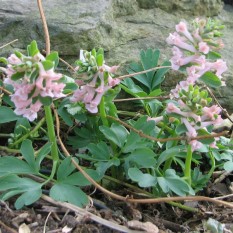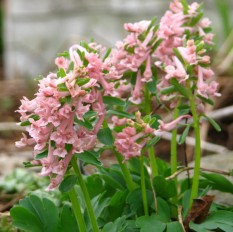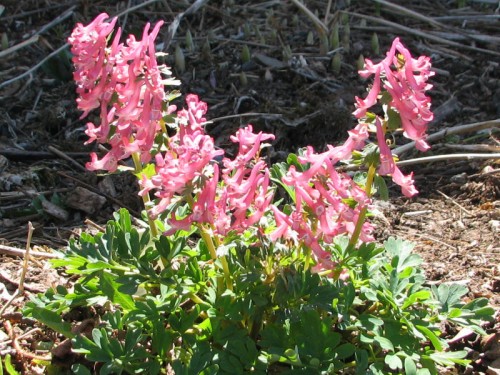In September 2004 I planted 4 different Corydalis bulbs that I had ordered from Odyssey Bulbs. They promised to be exquisite, so I could hardly wait until spring, and started patroling the vicinity as soon as the snow had melted. I especially wanted to see Corydalis bracteata (not offered this year), which owner Russell Stafford described thus:
Take Corydalis solida, enlarge its flowers, color them a rich, buttery yellow, and increase its vigor, and you’ve got this lovely species.
Did I mention I love yellow in the spring? Tragically (this is a gardener speaking), I never got to see this wonderful plant. There was a vole tunnel going directly to the spot marked by the tag. Voles! I screamed internally. Why was there no mention of rodents in the catalog? I could have taken precautions! Having thus become attuned to the grave threat to all my corydalis darlings, I looked over the rest of the planting locations with trepidation. Phew. Everyone else seemed okay.
This was Corydalis solida ‘Nettleton Pink’ last year. Yes, last year. This year, there is no ‘Nettleton Pink,’ and I don’t know why. I don’t see a vole tunnel, but that doesn’t mean it wasn’t eaten. It’s supposed to have “well-drained, humus-rich soil in partial to light shade,” and that’s what it’s got. All the other C. solida cultivars are up and blooming, and this one is supposed to be an earlier blooming variety. I am tempted to dig the area up to try to figure out what happened, even though it will probably mean replanting a nearby astilbe. But when there are so many other pressing garden tasks to be done, it doesn’t seem like doing a post-mortem should be the top item on my to-do list. Do you often dig up the plants that don’t make it to figure out why?

 Corydalis solida ‘Blushing Girl’ has managed to survive, and came back better than ever this year.
Corydalis solida ‘Blushing Girl’ has managed to survive, and came back better than ever this year.
C. solida ‘Pink Splash’ is also still alive. It blooms later than the others, and I don’t seem to have a photo of it, probably because there are too many other flowers competing for attention at that point. Last year after it bloomed I relocated it so that it was easier to see, and while it sent up foliage this year, I don’t think it will bloom.
I hope to acquire more corydalis as the years go by, but I will place grit around any new acquisitions, or maybe make little cages out of hardware cloth (aka rat wire) to plant them in. For a perennial plant, they weren’t that expensive, but when you think of them as individual tubers, and compare them to daffodil or crocus bulbs, they sure seem expensive. I really don’t want to lose any more to rodent food.





Every gardener should experiment and adapt. @ Sandra Hey there are many good organic products which are good for garden care.. if we use natural products for gardening then overfeeding would not harm plants..
After I wrote this post I eventually did dig up ‘Nettleton Pink.’ Well, I dug up the area but I didn’t find a trace of it. And I not only had a label in the ground but a written notation of where I had planted it. If it didn’t get eaten it rotted very thoroughly.
Pathology is a science too rarely applied by horticulturalists. Does anyone know of a book of gardening pathology with photos of dug-up sick and dead perennials? If not, perhaps one should be written.
Carol–I agree with Ted, Corydalis solida is very easy and tends to self-seed. I think my cultivars are just selections and not hybrids, and so should be just as easy. If you go to Odyssey Bulbs, it explains how different corydalis have different requirements. I tried to stick with the ones that needed moist soil. I think, Mary Ann, that there were other kinds that would be well suited to Boise.
I’ve killed lots of corydalis species – lutea, elata, ochroleuca, flexuosa, to name a few. But solida has done great everywhere. I’d definitely try it in Boise!
Corydalis is a tough plant to work with sometimes.
Jeeeez, at least you tried to grow it! Corydalis is not well suited to Boise. I have to admire them in catalogues, on the shelf in nurseries, and in gardens elsewhere.
Corydalis… a plant I’ve not heard much about, but now think I should try some. That’s what I like about garden blogs… always something new to discover.
Kathy, As soon as I got off line I started wondering about my geneology. So I got out all my references and it turns out corydalis is closely related to dicentra (bleeding heart, dutchman’s breechs et al,that seems obvious looking at the plants) but the next closest group are the poppies not the buttercups. Both similar iconic flowers and both seem fairly pest resistant, but clearly not the same.
Check before you post is I guess the moral for me. But that’s not as much fun as just pontificating!
So are the cultivars of C. solida really much better then the species? I love my plants and can imagine them being much better. Also thanks for the link to Odyssey Bulbs – looks like an interesting place!
Ted, I have the straight species, too, and it has done some moderate seeding. What you say about corydalis’ plant relations does give me pause. I, too, have noticed that rodent resistance or vulnerability runs in plant families. But, boy, that tunnel went straight to C. bracteata. I really don’t know what to think, now. Thanks for stopping by.
I have only the straight species of C. solida and it seeds about and is very happy in my sandy loamy shade garden.
I have lots of voles and mole and all other tunneling varmits digging through my garden and they don’t seem to bother the corydalis so far.
From what I remenber corydalis are very closely related to dicentra and part of the large ranunculus family. Its kin, peony, anemone, monkshood, are very varmit resistant.